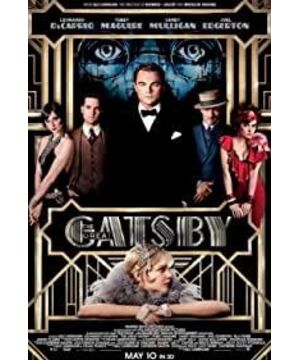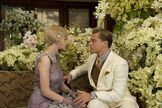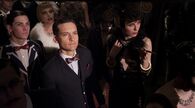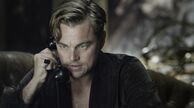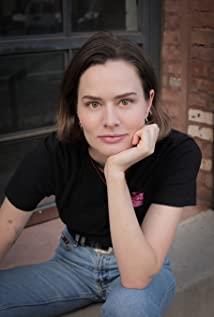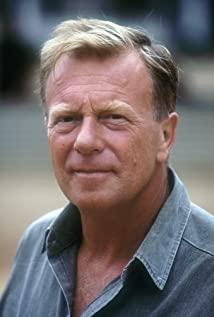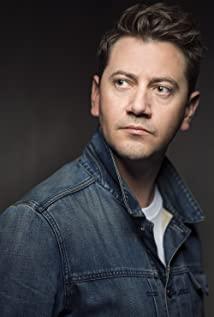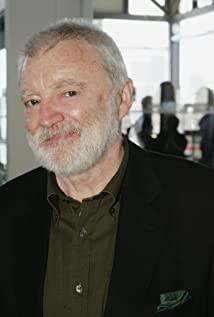When almost all top novels are brought to the screen, it is a journey of Sisyphus—two realms so different, that if the novel has reached the realm, then everything that has found a perfect home in the kingdom of words, It is difficult to make a new face in sound and shadow to climb to the top again.
The 2013 version of the film The Great Gatsby was not spared either. The film uses dazzling 3D visual effects to set off the prosperity and hustle and bustle of New York in the Jazz Age. It retains the entire narrative structure and restores more than 80% of the plot. The lines and monologues are copied in large sections, but they are still very different from the original work. The gorgeous scenes make the film look like a musical without arias.
Listening to
Gatsby's story in the brocade of flowers is very simple and can be told in a few sentences. A mysterious young tycoon throws a party in his mansion that seems to be open to everyone, but he sings every night not for pleasure, but in the hope that his married lover, Daisy, will one day walk into his open room like everyone else. door. He also got what he wanted and relived the dream with Daisy, but the good times didn't last long. Daisy's love for him was not firm. A series of seemingly coincidental but inherently logical events made him take his life and send him away. It was the indifference and selfishness of Daisy and her husband Tom that made the journey. His death was accompanied by scandal and slander, and the mansion that was once full of friends was left empty at the time of the funeral.
At one point, the novel had a fate as bleak as Gatsby's, selling less than half of Fitzgerald's first two novels, Paradise on Earth and Beauty and the Ugly. During his lifetime, less than 20,000 copies were printed. In the end, he seemed to believe that Gatsby would be forgotten. In 1940, he wrote in a letter to a friend: "Even now, few American novels have come out with my imprint; in a low-key way, I am unique." died of illness.
From the Great Depression to World War II, the novel sat dormant for two decades, only to be rediscovered in a reprint in the 1950s, and T.S. Eliot called it "the first step in American fiction since Henry James." ", ranked second in the list of the 100 best English novels of the 20th century selected by the American Modern Library.
What gives this novella its status? Today, we all say with hindsight, it was Fitch who presciently represented the illusion behind the glitz of the Jazz Age. Obviously, the author did not use reason and arithmetic to deduce the inevitable arrival of the Great Depression, but a genius writing like a god. Then one more question, why did Fitzgerald get the "oracle"?
In 1934, Random House included the novel in the "Modern Series", and the author's foreword may be an answer: "During the ten months of writing this book, the author has made an unprecedented effort to keep the The purity of his own artistic conscience", "It seems to me that the author has a clear conscience, as far as the truth or near truth is concerned, because he has done his best to make his imagination honest and believable."
Compared to the film version, the 1974 version plays Xiaoqingxing, the 2013 edition saw a good stage for the beauty of the prosperous world with flowers, brocade and fire cooking oil, but the faint sadness under the prosperous world, the truth of an era, only the pursuit of artistic truth with a pure heart. People, like Fitzgerald in 1924, had a chance to peek. An important reason why most of the adaptations of famous novels are difficult to recite the original works is that the world is full of fascinating eyes, and there are too few people who can achieve the truth and follow them under the beautiful words of the famous novels.
One of the great oddities of Gatsby's fiction and reality
is that we don't know what Gatsby looks like when we close the book. When Nick, the first-person narrator, first met him, he was just a "man of my grade", a "good-looking, middle-aged man". Appearance descriptions are completely discarded. He walks around in the story, and he ends up as the far-off shadow in the moonlight at the end of the first chapter.
What defines Gatsby is his smile. "It's a smile that's extremely rare, with a reassuring feeling that maybe you'll only encounter four or five times in your life. It's a smile that, for a split second, faces -- or seems to face, the entire world of eternity. , yet in another moment, it condenses on you, showing an irresistible preference for you." As it was her voice that defined Daisy, "there was a singing desire in her voice, a soft, soft voice. 'Listen' in the language, a deep commitment".
His smile and her voice are indescribable, and they go straight to the truth, the double truth of human heart and art. Daisy's voice was addicting, but Nick saw through her the first time he visited her mansion, and he "felt that what she said was not genuine", "it made me very uncomfortable, as if the whole night was a A trap, trying to get the emotions that are useful to her from me." That's exactly Daisy's strategy for everyone. In her voice "it's all money", she promises everything, tempting to put all her dreams into practice, isn't this a symbol of the era when the exterior is flashy but the interior is empty, and will eventually fail everyone ? Gatsby had looked over at the green light on Daisy's pier on the other side, and it was a proof that Daisy was within his sight. The title of the novel ends, "Gatsby believes in that green light, which is a symbol of the bright future that fades away in front of our eyes year by year." What the protagonist pursues with all his heart is also an old dream that a generation has indulged in. , in this sense, Fitzgerald got the "oracle".
What is rare is that this kind of writing method that goes straight to the real in the illusory and vague is not only reflected in the characterization of the characters, but even the description of the scenes that are most easily drawn in large strokes, the novel strives to make them virtual. The most amazing is the Grey Sands Valley between Long Island and New York. "Here, the gray sand grows like wheat, forming ridges, hills, and gardens of strange shapes." "Finally, here is a group of earth-grey people, which seem to be moving vaguely, but The dusty air is about to dismember them." Ashes will grow, grow into adults, and be dismembered by dust. Of course, these are not true. We don't even know what these "ash people" look like and what kind of work they are engaged in. , but these are not important, an urban fringe that has been eroded and destroyed by industrialization and urbanization has come to the fore.
Who let Gatsby throw so many parties
to show his smile and voice, no matter how beautiful the sound and shadow are, it will never be as fascinating as the blank space left by the words. But the novel still leaves some concrete images that can be grasped. At least there is that green light, which no director will let go.
There are still some highlights at the end of the film. Nick revisited Gatsby's villa for the last time, and the video imagined the situation when the latter first recognized the lamp on the other side, with Nick's inner monologue: "He has come a long way to this blue sky. On the green lawn, his dream seemed so close at hand, within reach, almost impossible to catch. He didn't know the dream was far away from him" and the green light "slipped past us, but that's okay-- Tomorrow we will run faster and stretch our arms farther... There will always be a bright morning..." "So we fought hard and sailed against the current, but we were destined to be washed back incessantly."
This immortal monologue of the original book, Condensed out is not just a person, or a jazz age situation. The words, sounds and images that exist as art are imitations of reality. It is not difficult for these imitations to leave a record of reality and create a pleasant or sad beauty. The most difficult thing is to touch people's real pursuits and fears, Love and indifference, some categories, such as commercial films, even deliberately avoid this because it makes the audience uncomfortable. And the green light that Fitzgerald gave Gatsby to hope and death can change in the hearts of thousands of readers into thousands of knots that they can't get, or lose when they get it.
Although this epilogue is copied, and although the dialogue and narration repeatedly point out that Daisy is a dream to Gatsby, and the contrast between the purity of the dream and the filth of reality, the anachronistic hip-hop soundtrack and the male protagonist of the whole film have always been over-stressed. The performance of the film and the temperament that the heroine does not match the role show that the director clearly expresses that he and Fitzgerald are not the same, and do not want to be the same. The author of the film does not have his own reflection on the glitz.
The different attitudes of the original book and the film to flashiness are most evident in Nick. The most obvious skill in the adaptation of the script is the go and stay in the adaptation of the details. Although most of the main plot is retained, there are many details in Luhrman's version that should not have been omitted, and should not have been added.
The book begins with what Nick's father taught him: "Whenever you want to judge someone," "Remember that not all people in the world have the same advantages as you." The film replaces the phrase with "Always try to see the best of people". These two sentences are inherently similar, but the new lines have no advantages except that they are easy to understand. One of the father's original words corresponds to the later plot of Gatsby's humble background, and the other is to emphasize Nick's background and upbringing. These two sentences are clear from the beginning, and this change also sets a different tone for Nick. In the original, Nick did reserve his opinions everywhere, even why he left his girlfriend, Miss Baker, without dissecting the reasons; whether at Gatsby's big party, or at Tom and his mistress's small party, he was always there. Is a calm outsider, can not be called happy. In the film, he, like the director, marveled at the party and the various video wonders of New York City and captured it.
The core of the replaced lines is to be kind to others. In the movie, Nick plays Gatsby's side more as a friend than a bystander. Gatsby was shot and killed while waiting for Daisy's call. Nick couldn't find him on the phone, In the movie, Gatsby was shot when he heard the phone ring, and the movie was actually Nick calling. And Nick would yell at the hostile crowd while taking care of Gatsby's funeral, which wasn't there. In the novel, Nick, as a bystander, "found himself on Gatsby's side, and I was the only one" when Gatsby died after the wall was pushed by everyone. This recognition and support, and the kindness of a good friend. are two things.
Because Nick is the narrator, the expressor of the author's point of view, the book and the film actually begin to crack at the very first line. This version of "The Great Gatsby", to the director, is like an adaptation of "Romeo and Juliet", it's just a different stage to perform "Moulin Rouge", who made Gatsby throw so many parties? ?
View more about The Great Gatsby reviews


